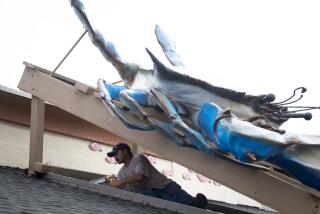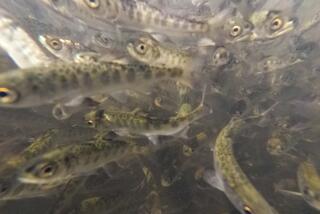More oil diverted to ship, but damage from slick spreads
- Share via
Reporting from New Orleans — The increased flow of oil diverted from a blown well to a ship offered a glimmer of hope that the spill in the Gulf of Mexico was slowly being contained, but concerns grew Sunday as resources to protect the coastline were stretched thin and wildlife casualties mounted.
FOR THE RECORD:
Oil spill and wildlife: An article in Monday’s Section A about wildlife casualties of the spill in the Gulf of Mexico said that birds contaminated with oil had shown up in Texas. No birds associated with the gulf spill have been collected in Texas. A statement Monday from the Fish and Wildlife Service said the mistake appeared in its report and was the result of a data input error. —
The number of birds picked up by wildlife rescue workers in five gulf states jumped by nearly 100 from Saturday’s toll. Of the 820 birds found so far, 597 were dead, and all 223 found alive had oil on them.
For the first time, birds contaminated with oil showed up in Texas, underscoring Coast Guard Adm. Thad Allen’s warning that the massive spill had splintered into “literally hundreds of thousands” of smaller slicks pushed in different directions by winds and currents.
“Yesterday and today, it has really hit home,” said Larry Arbanas, part of a team from the Cornell Lab of Ornithology that has been in Louisiana for eight days documenting damage to wildlife.
In Alabama, oil washed onto Orange Beach’s white sand after a boom broke and no skimmer was immediately available.
Florida Gov. Charlie Crist said he was setting up a task force of lawyers to be prepared to demand additional compensation from BP “when that becomes necessary.”
“And we are pretty certain that it will,” Crist said in a CNN interview.
Crist said that so far all of his requests for equipment had been met, but he noted that demand for skimmer boats and booms was bound to increase with oil encroaching on five states.
Allen also warned that shortfalls were likely.
“Frankly, the further this gets disaggregated from west to east, it’s going to create a continual demand, so there will always be an unmet demand for skimming capability, in my view,” he told ABC’s “This Week.” Each slick can be anywhere from dozens of yards to several miles wide, he said.
Allen also said that even though the amount of oil pumped up to a ship had increased, he would not agree with BP’s senior vice president, Bob Fryar, who said Saturday that he was “very pleased” with the progress.
BP said Sunday it had diverted 10,500 barrels of oil — 441,000 gallons — to the surface since Saturday, compared with 6,000 barrels the previous day.
“Nobody should be pleased” until relief wells designed to stop the spill are finished, sometime in August, Allen said on CNN’s “State of the Union.” In the meantime, he said, the spill remains “an insidious enemy that is attacking all of our shores. It’s holding the gulf hostage, basically.”
Nearly seven weeks after the oil rig blast that led to the nation’s worst oil spill, the amount of crude gushing from the damaged well remains uncertain. A government panel has estimated the leak at 12,000 to 19,000 barrels a day, roughly half a million to nearly 800,000 gallons. By that measure, BP’s cap could be diverting 55% to 88% of the spill.
But live video of billowing clouds of oil escaping from the cap provoked Rep. Edward J. Markey (D-Mass.) to demand better disclosure of the flow.
“At this time, BP appears to know how much oil is being captured, which is encouraging,” Markey wrote in a letter to BP America Chief Executive Lamar McKay. “Yet BP still does not appear to know precisely how much oil is actually escaping, which is discouraging.”
It also is unclear how much spillage will be contained once the vents on the containment cap atop the well’s failed blowout preventer are closed. Allen said the vents must be closed gradually to avoid putting too much pressure on the cap.
Wildlife officials, meanwhile, battled the leading edge of the oil surge at tourist destinations in Florida’s Panhandle and isolated barrier islands that provide shelter to nesting birds and sea turtles.
National Park Service officials were responding to tar balls and mats of oil washing up in parts of Gulf Islands National Seashore, a string of barrier islands off the coasts of Mississippi and Florida. In addition, Alabama’s Dauphin Island, which is part of the barrier island chain but not part of the national seashore, has been hit with oil.
Joan Anzelmo of the park service confirmed Sunday that Horn and Petit Bois islands in Mississippi and Perdido Key, Fort Pickens and Opal Beach in Florida also had oil. All of the national parks on the gulf remained open, but Anzelmo said officials were preparing for oil landfall at eight of them.
Petit Bois and Horn islands are all the more precious to Mississippi because, along with a small tract of forest land, they represent the only wilderness in the state. “That’s it, that’s all we’ve got,” said Louie Miller of the Sierra Club. “Those islands are unique to the northern gulf and in pristine condition.”
Petit Bois is one of the last undeveloped barrier islands in the gulf.
The latest tallies of wildlife collected showed a sharp jump, particularly in Louisiana, where the number of birds collected, both dead and alive, went from 358 to 404 from Saturday to Sunday. Seventy sea turtles have been picked up in the state, 66 of them dead. The number of reptiles, birds, turtles and mammals such as dolphins collected along the gulf stood at 1,143 Sunday, 107 more than the previous day. In Texas, 46 dead birds were picked up.
The three-member Cornell team, which arrived Sunday at sunrise on East Grand Terre Island, quickly spotted a young herring gull whose white breast feathers had turned orange. The gull appeared in relatively good shape, team members said, but they added that lightly covered birds often were most at risk because they are difficult to catch and treat.
Benjamin Clock crossed the deserted island to the beach, where he saw something barely moving under a large patch of oil. It was a snake, unrecognizable beneath its coat of oil except for its flickering tongue. The team watched as the reptile, its tail stuck in the slick, struggled to free itself. Just when it seemed on the verge of escape, a wave washed it back into the tar pit.
Biologist Marc Dantzker lifted the snake with a stick and carried it by hand to clean sand on the shore, where it wriggled for several minutes before heading toward grass in the middle of the island. Only then could he identify it as a speckled king snake.
The team also came upon what looked like a dead snowy egret, unrecognizable in its oily grave. “It looked like a bird fossil, an imprint of a bird in muck. It was awful,” said Dantzker, who believes that “only a fraction” of dead birds have been found. He called wildlife rescue teams to alert them to the day’s findings, which included an oil-covered pelican still alive on the shore.
Rescue workers plucked the pelican from the sand and took it to a rehabilitation center to be cleaned and eventually released back into the wild in Florida.
Times photographer Carolyn Cole on East Grand Terre Island and Noam Levey of the Washington bureau contributed to this report.
More to Read
Sign up for Essential California
The most important California stories and recommendations in your inbox every morning.
You may occasionally receive promotional content from the Los Angeles Times.















